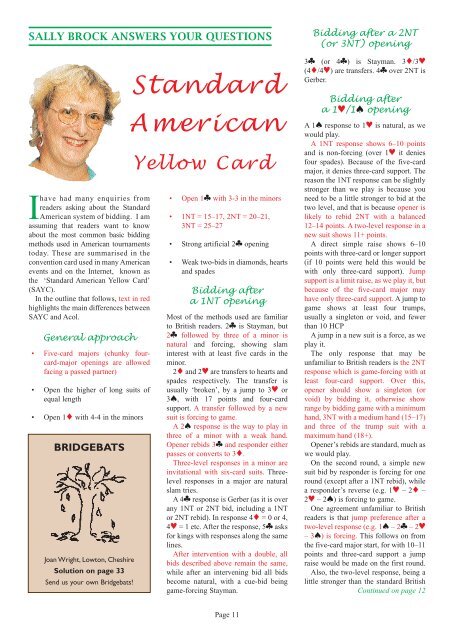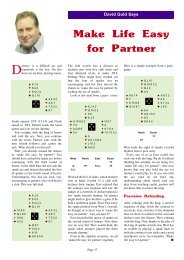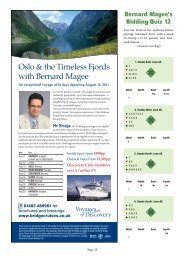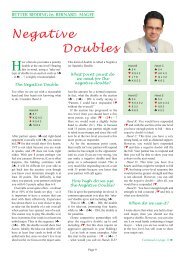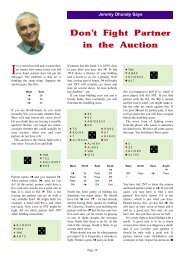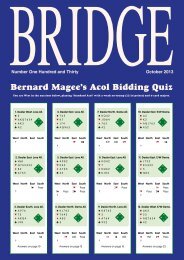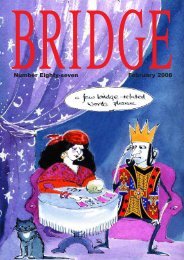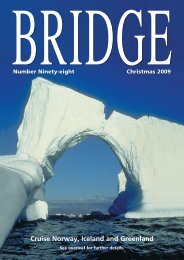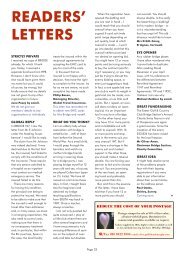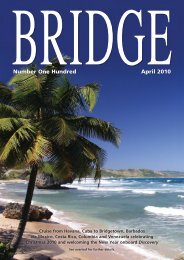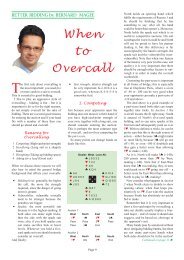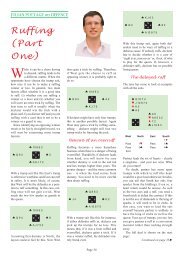Standard American Yellow Card - Mr Bridge
Standard American Yellow Card - Mr Bridge
Standard American Yellow Card - Mr Bridge
Create successful ePaper yourself
Turn your PDF publications into a flip-book with our unique Google optimized e-Paper software.
SALLY BROCK ANSWERS YOUR QUESTIONS<br />
Ihave had many enquiries from<br />
readers asking about the <strong>Standard</strong><br />
<strong>American</strong> system of bidding. I am<br />
assuming that readers want to know<br />
about the most common basic bidding<br />
methods used in <strong>American</strong> tournaments<br />
today. These are summarised in the<br />
convention card used in many <strong>American</strong><br />
events and on the Internet, known as<br />
the ‘<strong>Standard</strong> <strong>American</strong> <strong>Yellow</strong> <strong>Card</strong>’<br />
(SAYC).<br />
In the outline that follows, text in red<br />
highlights the main differences between<br />
SAYC and Acol.<br />
General approach<br />
• Five-card majors (chunky fourcard-major<br />
openings are allowed<br />
facing a passed partner)<br />
• Open the higher of long suits of<br />
equal length<br />
• Open 1♦ with 4-4 in the minors<br />
BRIDGEBATS<br />
Joan Wright, Lowton, Cheshire<br />
Solution on page 33<br />
Send us your own <strong>Bridge</strong>bats!<br />
<strong>Standard</strong><br />
<strong>American</strong><br />
<strong>Yellow</strong> <strong>Card</strong><br />
• Open 1♣ with 3-3 in the minors<br />
• 1NT = 15–17, 2NT = 20–21,<br />
3NT = 25–27<br />
• Strong artificial 2♣ opening<br />
• Weak two-bids in diamonds, hearts<br />
and spades<br />
Bidding after<br />
a 1NT opening<br />
Most of the methods used are familiar<br />
to British readers. 2♣ is Stayman, but<br />
2♣ followed by three of a minor is<br />
natural and forcing, showing slam<br />
interest with at least five cards in the<br />
minor.<br />
2♦ and 2♥ are transfers to hearts and<br />
spades respectively. The transfer is<br />
usually ‘broken’, by a jump to 3♥ or<br />
3♠, with 17 points and four-card<br />
support. A transfer followed by a new<br />
suit is forcing to game.<br />
A2♠ response is the way to play in<br />
three of a minor with a weak hand.<br />
Opener rebids 3♣ and responder either<br />
passes or converts to 3♦.<br />
Three-level responses in a minor are<br />
invitational with six-card suits. Threelevel<br />
responses in a major are natural<br />
slam tries.<br />
A4♣ response is Gerber (as it is over<br />
any 1NT or 2NT bid, including a 1NT<br />
or 2NT rebid). In response 4♦ = 0 or 4,<br />
4♥ = 1 etc. After the response, 5♣ asks<br />
for kings with responses along the same<br />
lines.<br />
After intervention with a double, all<br />
bids described above remain the same,<br />
while after an intervening bid all bids<br />
become natural, with a cue-bid being<br />
game-forcing Stayman.<br />
Page 11<br />
Bidding after a 2NT<br />
(or 3NT) opening<br />
3♣ (or 4♣) is Stayman. 3♦/3♥<br />
(4♦/4♥) are transfers. 4♣ over 2NT is<br />
Gerber.<br />
Bidding after<br />
a 1♥/1♠ opening<br />
A1♠ response to 1♥ is natural, as we<br />
would play.<br />
A 1NT response shows 6–10 points<br />
and is non-forcing (over 1♥ it denies<br />
four spades). Because of the five-card<br />
major, it denies three-card support. The<br />
reason the 1NT response can be slightly<br />
stronger than we play is because you<br />
need to be a little stronger to bid at the<br />
two level, and that is because opener is<br />
likely to rebid 2NT with a balanced<br />
12–14 points. A two-level response in a<br />
new suit shows 11+ points.<br />
A direct simple raise shows 6–10<br />
points with three-card or longer support<br />
(if 10 points were held this would be<br />
with only three-card support). Jump<br />
support is a limit raise, as we play it, but<br />
because of the five-card major may<br />
have only three-card support. A jump to<br />
game shows at least four trumps,<br />
usually a singleton or void, and fewer<br />
than 10 HCP<br />
A jump in a new suit is a force, as we<br />
play it.<br />
The only response that may be<br />
unfamiliar to British readers is the 2NT<br />
response which is game-forcing with at<br />
least four-card support. Over this,<br />
opener should show a singleton (or<br />
void) by bidding it, otherwise show<br />
range by bidding game with a minimum<br />
hand, 3NT with a medium hand (15–17)<br />
and three of the trump suit with a<br />
maximum hand (18+).<br />
Opener’s rebids are standard, much as<br />
we would play.<br />
On the second round, a simple new<br />
suit bid by responder is forcing for one<br />
round (except after a 1NT rebid), while<br />
a responder’s reverse (e.g. 1♥ – 2♦ –<br />
2♥ – 2♠) is forcing to game.<br />
One agreement unfamiliar to British<br />
readers is that jump preference after a<br />
two-level response (e.g. 1♠ – 2♣ – 2♥<br />
– 3♠) is forcing. This follows on from<br />
the five-card major start, for with 10–11<br />
points and three-card support a jump<br />
raise would be made on the first round.<br />
Also, the two-level response, being a<br />
little stronger than the standard British<br />
Continued on page 12
SALLY BROCK ANSWERS YOUR QUESTIONS continued from page 11<br />
equivalent, promises another bid, so<br />
sequences such as 1♠ – 2♣ – 2♦, or<br />
1♠ – 2♣ – 2♠ are forcing for one<br />
round. But, given that responder should<br />
have an 11-count, he would presumably<br />
want to bid anyway.<br />
Bidding after<br />
a 1♣/1♦ opening<br />
The only time a 1♦ opening will be made<br />
on a three-card suit is with a 4-4-3-2<br />
distribution, therefore the sequence 1♦<br />
– 1♥/1♠ – 1NT guarantees four<br />
diamonds. In general, bidding is as<br />
above. More trumps are needed to raise<br />
minors than majors (four to raise 1♦,<br />
and five to raise 1♣, though one less<br />
trump will do in competition).<br />
Responses of 2NT and 3NT are gameforcing<br />
and balanced, 2NT showing<br />
13–15 and 3NT 16–17. There is no<br />
forcing minor-suit raise.<br />
Bidding after<br />
a 2♣ opening<br />
Responses other than 2♦ are natural,<br />
showing five-card suits and 8 or more<br />
points. 2♦ is either a negative or a<br />
waiting bid with fair values unsuitable<br />
for a positive response.<br />
After a 2NT rebid (22–24), the<br />
bidding is as over an opening 2NT.<br />
After a 2♦ negative, the bidding is<br />
only forcing to three of opener’s major<br />
or four of his minor. A sequence such as<br />
2♣ – 2♦ – 2♥ – 2♠ – 3♥ is nonforcing.<br />
But any new suits bid by<br />
opener are forcing for one round.<br />
Bidding<br />
after a weak<br />
two bid<br />
Weak two bids show a six-card suit of<br />
reasonable quality and 5–11 points.<br />
They may occasionally be made on a<br />
very good five-card suit, or indeed on a<br />
poor seven-card suit unsuitable for<br />
opening at the three level.<br />
All responses other than raises are<br />
forcing (they call this ‘RONF’: Raise<br />
Only Non Force). A 2NT response is<br />
forcing, showing game interest and<br />
implying some sort of fit for opener.<br />
Opener should rebid his suit with a<br />
minimum, show a high-card feature<br />
(ace or king) with a maximum, or with<br />
a maximum without a high-card feature<br />
raise to 3NT and let responder place the<br />
contract.<br />
Slam bidding<br />
<strong>Standard</strong> Blackwood is used, with a<br />
subsequent 5NT asking for kings. A<br />
jump to 5NT is a grand slam force, in<br />
response to which a bid of seven of the<br />
trump suit shows two top honours and a<br />
bid of six denies two top honours.<br />
Defensive bidding<br />
Overcalls show 8–16 points (double and<br />
then bid the long suit with a stronger<br />
hand). The only forcing response to an<br />
overcall is a cue-bid of opener’s suit; in<br />
response to this the overcaller rebids his<br />
suit with a minimum and makes some<br />
other bid with extra values.<br />
A 1NT overcall shows 15–18 points<br />
and a balanced hand. In response to this<br />
2♣ is Stayman, but all other responses<br />
are natural. A 1NT overcall in the<br />
balancing position shows 10–15.<br />
Jump overcalls are weak, showing<br />
hands that would have opened at that<br />
level and vulnerability.<br />
A jump overcall of 2NT shows 5-5 in<br />
the lower two unbid suits. A cue-bid<br />
when the opponents have bid only one<br />
suit is Michaels (when they have bid<br />
two suits both cue-bids are natural).<br />
Doubles are for take-out over all<br />
opening bids below game. A belowgame<br />
jump response to a take-out<br />
double is non-forcing. The only forcing<br />
Page 12<br />
response to a take-out double is a cuebid.<br />
Competitive bidding<br />
Negative doubles are used against<br />
overcalls up to and including 2♠ and<br />
these promise four cards (at least) in<br />
any unbid major. Otherwise bids show<br />
what they would have shown without<br />
the intervention, i.e. a bid at the two<br />
level shows 11+ points and a five-card<br />
suit. Cue-bidding RHO’s suit (e.g. 1♠ –<br />
2♣ – 3♣) shows the values for game<br />
without clear direction for the moment<br />
(and is often used to show a gameforcing<br />
raise).<br />
After an opposing take-out double, a<br />
simple bid at the one level is forcing, as<br />
without the double, but a new suit at the<br />
two level is non-forcing, showing 6–10<br />
points. 2NT is a limit raise, while jump<br />
raises are pre-emptive. A jump in a new<br />
suit is pre-emptive, like a weak two or<br />
three opening. Redouble shows a hand<br />
of 10 or more points.<br />
So there you have it. In truth, much of<br />
it is the same as we play over here –<br />
gone are the days of game-forcing jump<br />
raises. Many of the differences stem<br />
from the strong no-trump five-card<br />
major base. By opening 1NT in this<br />
country it means we do not have to deal<br />
with balanced hands in the 12–14 range<br />
when we open something else, in the<br />
US it is the 15–17 balanced hands that<br />
are eliminated from other sequences.<br />
Any of you who are thinking of playing<br />
on the internet may find this useful. My<br />
experience is that if I am playing with a<br />
stranger I would rather play his system<br />
than have him trying to play mine!<br />
To commemorate the GOLDEN JUBILEE of Queen Elizabeth II,<br />
I have commissioned a twin set of cards, one blue-backed and one red.<br />
These cards have been made from best-quality card<br />
and are plastic-coated to ensure that they will last.<br />
Their surface has been varnished to provide<br />
a smooth finish for ease of handling.<br />
Boxed together in a gold-coloured drop-lid gift box,<br />
they make a superb memento or a truly wonderful gift.<br />
£14.95 per boxed set inc p&p<br />
Two boxed sets £27. Four boxed sets £50.<br />
Available from 01483 489961<br />
Ryden Grange, Bisley, Surrey GU21 2TH.


